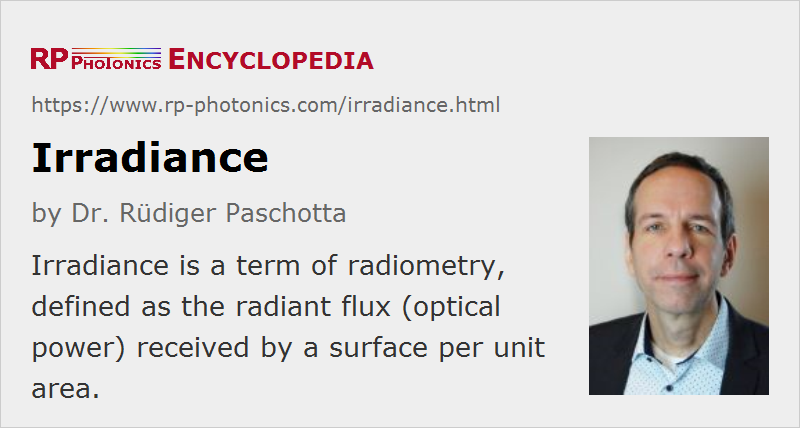Irradiance
Definition: the radiant flux (optical power) received by a surface per unit area
Alternative term: flux density
German: Bestrahlungsstärke, Intensität
Categories:  general optics,
general optics,  light detection and characterization,
light detection and characterization,  vision, displays and imaging,
vision, displays and imaging,  optical metrology
optical metrology
Units: W/m2, W/cm2
Formula symbol: <$E_\textrm{e}$>
Author: Dr. Rüdiger Paschotta
Cite the article using its DOI: https://doi.org/10.61835/utj
Get citation code: Endnote (RIS) BibTex plain textHTML
Irradiance (or flux density) is a term of radiometry and is defined as the radiant flux received by some surface per unit area. In the SI system, it is specified in units of W/m2 (watts per square meter). Irradiance may be applied to light or other kinds of radiation.

In the context of laser technology, the common term optical intensity has the same units as the irradiance. It is not the same quantity, however. It is important to realize that the intensity is defined as the amount of energy going through an area perpendicular to the beam, while irradiance refers to what amount of energy arrives on a certain surface with a given orientation. The irradiance caused by a laser beam, for example, which hits a workpiece under some angle <$\theta$> against normal direction, is the beam intensity times <$\cos \theta$>. The numerical value of the irradiance is thus generally smaller than that of the beam intensity. Irradiance may be caused by a combination of multiple light sources.
One should also avoid confusion of optical intensity with the term radiant intensity, which has a different meaning: the radiant flux per unit solid angle.
A related quantity is the spectral irradiance, which is the irradiance per unit frequency or wavelength interval. It has units of W / (m2 Hz) or W / (m2 nm), for example.
The corresponding photometric quantity is the illuminance.
The related term radiance essentially means irradiance per unit solid angle, apart from a <$\cos \theta$> factor.
Measurement of Optical Irradiance
Irradiance values can be measured with suitable photodetectors. For accurate measurements, they should have the following properties:
- Within the relevant spectral region, the responsivity should have a low wavelength dependence. For a photon detector such as a photodiode, that implies that the quantum efficiency must be inversely proportional to the optical wavelength.
- The detector should have the correct angular dependence of its sensitivity. This means that incident photons should contribute to the measurement signal with no dependence on their incidence angle.
More to Learn
Encyclopedia articles:
Questions and Comments from Users
Here you can submit questions and comments. As far as they get accepted by the author, they will appear above this paragraph together with the author’s answer. The author will decide on acceptance based on certain criteria. Essentially, the issue must be of sufficiently broad interest.
Please do not enter personal data here; we would otherwise delete it soon. (See also our privacy declaration.) If you wish to receive personal feedback or consultancy from the author, please contact him, e.g. via e-mail.
By submitting the information, you give your consent to the potential publication of your inputs on our website according to our rules. (If you later retract your consent, we will delete those inputs.) As your inputs are first reviewed by the author, they may be published with some delay.





2021-11-16
This concept is really confusing for me, in the context of light hazard and eye safety, specifically ophthalmology... the corneal maximum allowed infrared radiant exposure (corneal irradiance) is defined as: averaging the highest localized radiant power incident upon a circular area of 1mm diameter. This value is set to be less than 20 mW/cm2 or 100 mW/cm2 (depending on the class of devices). Most current devices focus 1064-nm lasers, let's say with a f = 125 mm lens, on the cornea with around 2 mW average power and are deemed safe! I don't understand in this context how is irradiance of the 1 mm diameter surface of cornea is defined that 2 mW focused laser is still safe??
The author's answer:
The irradiance of the cornea is relevant for radiation which is strongly absorbed in the cornea – e.g., for rather long wavelengths. In the case of 1064-nm lasers, however, the critical aspect is that the radiation can be focused to the much more sensitive retina. In such cases, the irradiance on the cornea (the entrance of the eye) is not the relevant quantity: it cannot be used to estimate the relevant intensity on the retina.